Stimulating the Impact of Hydrocarbon Micro-Seepage on Vegetation in Ugwueme, from 1996 to 2030, Based on the Leaf Area Index and Markov Chain Model †
Abstract
1. Introduction
2. Materials and Methods
2.1. Materials
2.2. Methods
Image Pre-Processing and Classification
2.3. Stimulation of Future LAI Dynamics
2.3.1. Markov Chain Model
2.3.2. Cellular Automata Model
2.3.3. CA–Markov Model
3. Results and Interpretation
3.1. Classification Analysis and Rate of Changes
3.2. The Spectral Reflectance of Vegetation
3.3. The Stimulation Analysis
4. Conclusions
Author Contributions
Funding
Institutional Review Board Statement
Informed Consent Statement
Data Availability Statement
Conflicts of Interest
References
- Enoh, M.A.; Okeke, F.I.; Okeke, U.C. Automatic lineaments mapping and extraction in relationship to natural hydrocarbon seepage in Ugwueme, South-Eastern Nigeria. Geod. Cartogr. 2021, 47, 34–44. [Google Scholar] [CrossRef]
- Zheng, G.; Xu, W.; Etiope, G.; Ma, X.; Liang, S.; Fan, Q.; Sajjad, W.; Li, Y. Hydrocarbon seeps in petroliferous basins in China. A first inventory. J. Asian Earth Sci. 2018, 151, 269–284. [Google Scholar] [CrossRef]
- Noomen, M.F.; Van Der Werff, H.M.A.; Van Der Werff, F.D. Spectral and Spatial indicators of Botanical changes caused by long-term hydrocarbon seepage. Ecol. Inform. 2012, 8, 55–64. [Google Scholar] [CrossRef]
- Devi, A.; Boruah, S.; Gilfellon, G. Geochemical characterization of source rock from the north bank area, upper Assam basin. J. Geological. Soc. India 2017, 89, 429–434. [Google Scholar] [CrossRef]
- Bhagobaty, R.K. Hydrocarbon-utilizing bacteria of natural crude oil seepages. Digboi oil field, northern region of India. J. Sediment. Environ. 2020, 5, 177–185. [Google Scholar] [CrossRef]
- Kennicult, M. Oil and gas seeps in the Gulf of Mexico. In Habitats and Biota of the Gulf of Mexico: Before the Deepwater Horizon Oil Spill; Springer: New York, NY, USA, 2017; pp. 275–358. [Google Scholar]
- He, J.; Zhang, W.; Lu, Z. Seepage system of oil-gas and its exploration in Yinggehai basin located at NorthWest of South China Sea. J. Nat. Gas Geosci. 2017, 2, 29–41. [Google Scholar] [CrossRef]
- Garain, S.; Mitra, D.; Das, P. Mapping hydrocarbon micro-seepage prospect areas by integrated studies of aster processing, geochemistry and geophysical surveys in Assam-Arakan fold belt, NE India. Int. J. Appl. Earth Obs. 2021, 102, 102432. [Google Scholar]
- Shi, P.L.; Fu, B.H.; Ninomiya, Y.; Sun, J.; Li, Y. Multispectral remote sensing mapping for hydrocarbon seepage- induced lithologic anomalies in the Kuqa foreland basin, South Tian Shan. J. Asian Earth Sci. 2012, 46, 70–77. [Google Scholar] [CrossRef]
- Argentino, C.; Kate, A.W.; Sunil, V.; Stephane, P.; Stefan, B.; Giuliana, P. Dynamics and history of methane seepage in the SW Barents Sea: New insights from Leirdjupet fault complex. Sci. Rep. 2021, 11, 4373. [Google Scholar] [CrossRef]
- Etiope, G. Natural gas seepage. In The Earth’s Hydrocarbon Degassing; Springer: Basel, Switzerland, 2015; p. 199. [Google Scholar]
- Tangestani, M.H.; Validabadi, K. Mineralogy and geochemistry of alteration induced by hydrocarbon seepage in an evaporate formation. A case study from the Zagros Fold Belt, SW Iran. Appl. Geochem. 2014, 41, 189–195. [Google Scholar] [CrossRef]
- Giovanni, M.; Stefano, C.; Eleonora, S. Geological and Geochemical setting of natural hydrocarbon emissions in Italy. Adv. Nat. Gas Technol. 2012, 556. [Google Scholar] [CrossRef]
- Lillesand, T.M.; Kiefer, R.W. Remote Sensing and Image Interpretation, 3rd ed.; John Wiley and Sons: New York, NY, USA, 1994. [Google Scholar]
- Gitelson, A.A.; Kaufman, Y.J.; Stark, R.; Rundquist, D. Novel algorithms for remote estimation of vegetation fraction. Remote Sens. Environ. 2002, 80, 76–87. [Google Scholar] [CrossRef]
- Jin, Z.; Zhuang, Q.; Wang, J.; Archontoulis, S.; Zobel, Z.; Kotamarthi, V. The combined and separet impacts of climate extremes on the current and future US rainfed maize and soya-bean production under elevated CO2. Glob. Chang. Biol. 2017, 23, 2687–2704. [Google Scholar] [CrossRef]
- Enoh, M.A.; Okeke, U.C.; Barinua, N.Y. Modelling and delineation of hydrocarbon micro-seepage prone zone on soil and sediment in Ugwueme, South-Eastern Nigeria with Soil Adjustment Vegetation Index (SAVI). Int. J. Plant Soil Sci. 2020, 32, 13–33. [Google Scholar] [CrossRef]
- Wang, Z.; Qi, Z.; Xue, L.; Bukovsky, M.; Helmers, M.J. Modeling the impacts of climate change on nitrogen losses and crop yield in a subsurface drained field. Clim. Chang. 2015, 129, 323–335. [Google Scholar] [CrossRef]
- Aly, A.A.; Al-Qmran, A.M.; Sallam, A.S.; Al-Wabel, M.I.; Al-Shayann, M.S. Vegetation cover change detection and assessment in arid environment using multi-temporal remote sensing images and ecosystem management approach. Solid Earth 2016, 7, 713–715. [Google Scholar] [CrossRef]
- Fogwe, Z.N.; Tume, S.J.; Fouda, M. Eucalyptus Tree Colonization of the Bafut-Ngemba Forest Reserve, North West Region, Cameroon. Environ. Ecosyst. Sci. 2019, 3, 12–16. [Google Scholar] [CrossRef]
- Huete, A.R. A soil-adjusted vegetation index (SAVI). Remote Sens. Environ. 1988, 25, 295–309. [Google Scholar] [CrossRef]
- Breda, N.J. Ground-based measurements of leaf area index: A review of methods, instruments and current controversies. J. Expermintal Bot. 2003, 54, 2403–2417. [Google Scholar] [CrossRef]
- Jonckheere, I.; Fleck, S.; Nackaerts, K.; Muy, B.; Coppin, P.; Weiss, M.; Baret, F. Review of methods for in situ leaf area index determination: Part I. Theories, sensors and hemispherical photography. Agric. For. Meteorol. 2004, 121, 19–35. [Google Scholar] [CrossRef]
- Weiss, M.; Baret, F.; Smit, G.; Jonckeere, I.; Coppin, P. Review of methods for in situ leaf area index (LAI) determination: Part II. Estimation of LAI, errors and sampling. Agric. For. Meteorol. 2004, 121, 37–53. [Google Scholar] [CrossRef]
- Chen, J.M. Remote sensing of leaf area index of vegetation covers. In Remote Sensing of Natural Resources; CRC Press: Boca Raton, FL, USA, 2013; pp. 375–398. [Google Scholar]
- Parsa, V.A.; Yavari, A.; Nejadi, A. Spatio-temporal analysis of land use and land cover pattern changes in Arasbaran Biospshere Reserve, Iran. Model. Earth Syst. Environ. 2016, 2, 178. [Google Scholar]
- Teferi, E.; Bewket, W.; Uhlenbrook, S.; Wenninger, J. Understanding recent land use and land cover dynamics in the source region of the Upper Blue Nile, Ethopia. Spatially explicit statistical modelling of systematic transitions. Agric. Ecosyst. Environ. 2013, 165, 98–117. [Google Scholar] [CrossRef]
- Thomas, H.; Laurence, H.M. Modelling and projecting land-use and land-cover changes with a cellular automation in considering landscape trajectories: An improvement for simulation of plausible future states; EARsel. EARSeL eProceedings 2006, 5, 63–76. [Google Scholar]
- Guan, D.; Gao, W.; Watari, K.; Fukahori, H. Land use change of Kitakyushu based on landscape ecology and Markov model. J. Geogr. Sci. 2008, 18, 455–468. [Google Scholar] [CrossRef]
- Ma, C.; Zhang, G.Y.; Zhang, X.C.; Zhao, Y.J.; Li, H.Y. Application of Markov model in wetland change dynamics in Tianjin Coastal Area, China. Procedia Environ. Sci. 2012, 13, 252–262. [Google Scholar] [CrossRef]
- Subedi, P.; Subedi, K.; Thapa, B. Application of a hybrid cellular automation Markov (CA-Markov) model in land-use change prediction. A case study of saddle creek drainage Basin, Florida. Appl. Ecol. Environ. Sci. 2014, 1, 126–132. [Google Scholar]
- Singh, S.K.; Mustak, S.; Srivastava, P.K.; Szabo, S.; Islam, T. Predicting spatial and decadal LULC changes through Cellular Automata Markov Chain Models using earth observation datasets and geoinformation. Environ. Process. 2015, 2, 61–78. [Google Scholar] [CrossRef]
- Guan, D.; Li, H.; Inohae, T.; Su, W.; Nagaie, T.; Hokao, K. Modelling urban land use change by integration of cellular automation and Markov model. Ecol. Model. 2011, 222, 3761–3772. [Google Scholar] [CrossRef]
- He, D.; Zhou, J.; Gao, W.; Guo, H.; Yu, S.; Liu, Y. An integrated CA-Markov model for dynamic simulation of land use change in Lake Diachi watershed. Bejing Daxue Xuebao (Ziran Kexue Ban)/Acta Sci. Nat. Univ. Pekin. 2014, 50, 1095-05. [Google Scholar]
- Liping, C.; Yujun, S.; Saeed, S. Monitoring and predicting land use and land cover changes using remote sensing and GIS techniques. A case study of a hilly area, Jiangle, china. PLoS ONE 2018, 13, e0200493. [Google Scholar] [CrossRef] [PubMed]
- Yang, X.; Zheng, X.C.; Chen, R. A land-use change model. Integrating landscape pattern indexes and Markov-CA. Ecol. Model. 2014, 283, 1–7. [Google Scholar] [CrossRef]
- Memarian, H.; Balasundran, S.K.; Talib, J.B.; Sung, C.T.; Sood, A.M.; Abbaspour, K. Validation of CA-markov for simulation of land use and land cover change in the Langat basin, Malaysia. J. Geographic. Inf. Syst. 2012, 4, 542–554. [Google Scholar] [CrossRef]
- Hyandye, C.; Martz, L.W. A Markovian and Cellular Automata Land-Use Change Predictive Model of the Usangu catchment. Int. J. Remote Sens. 2017, 38, 64–81. [Google Scholar] [CrossRef]
- Blackburn, G.A. Hyper-spectral remote sensing of plant pigments. J. Exp. Bot. 2007, 58, 855–867. [Google Scholar] [CrossRef] [PubMed]
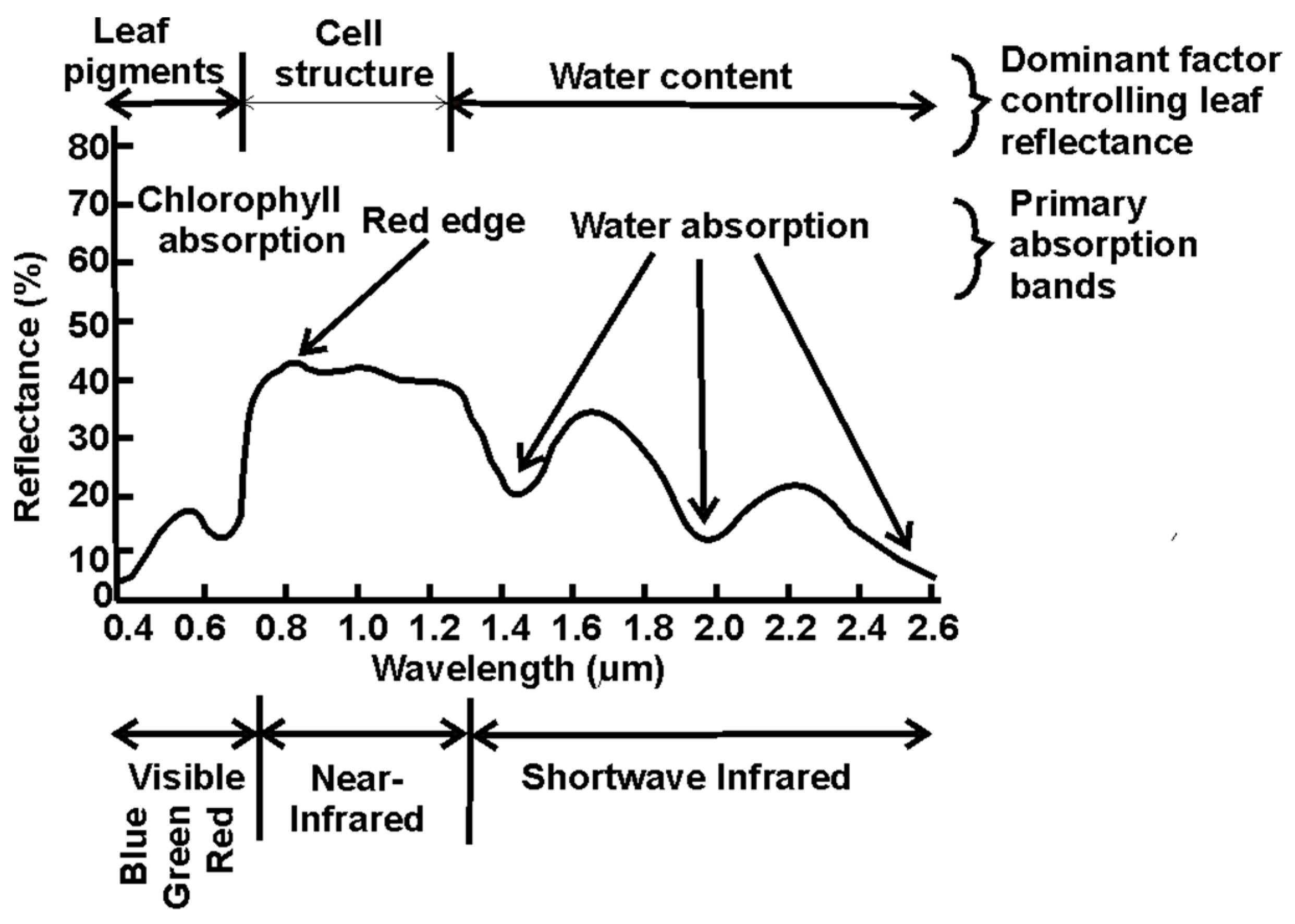
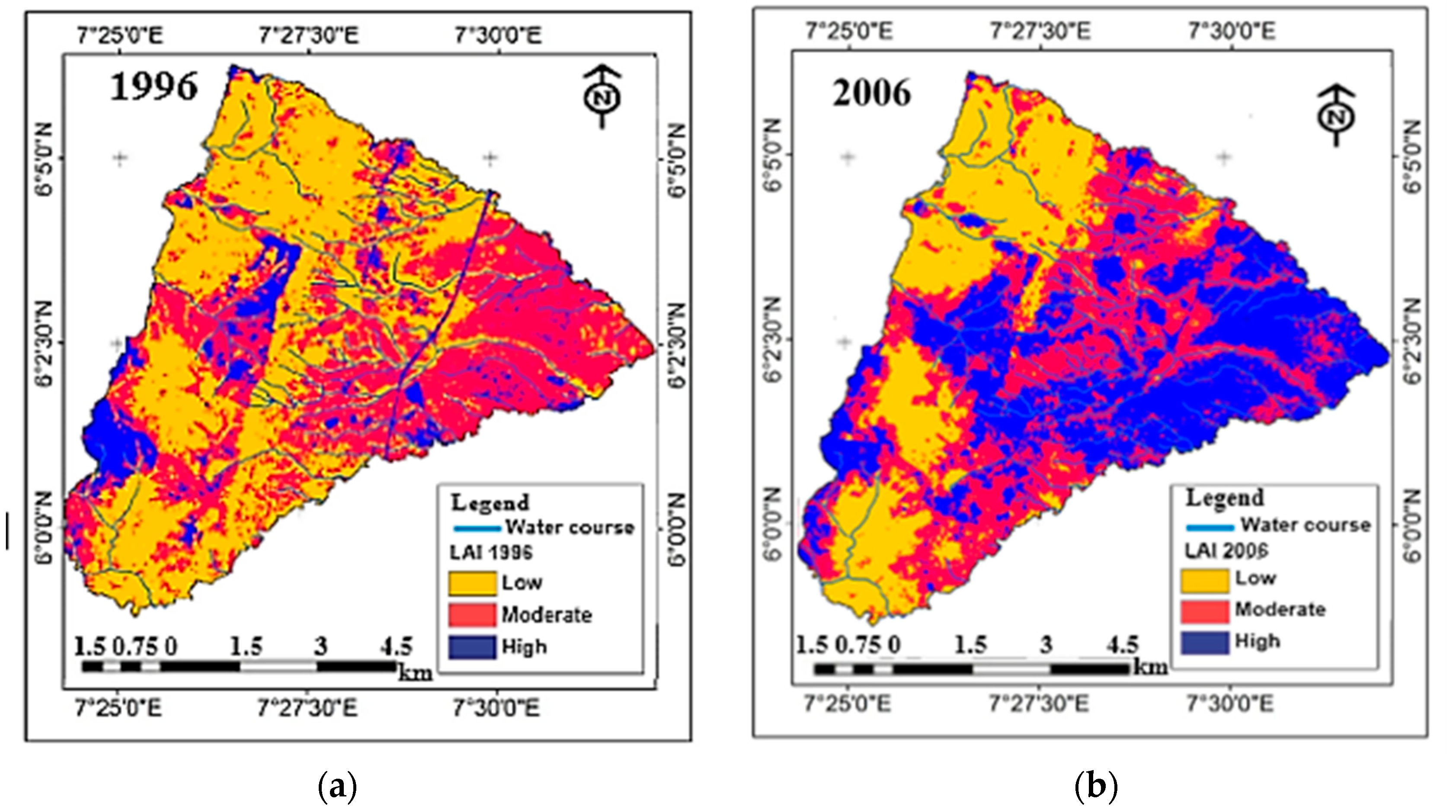
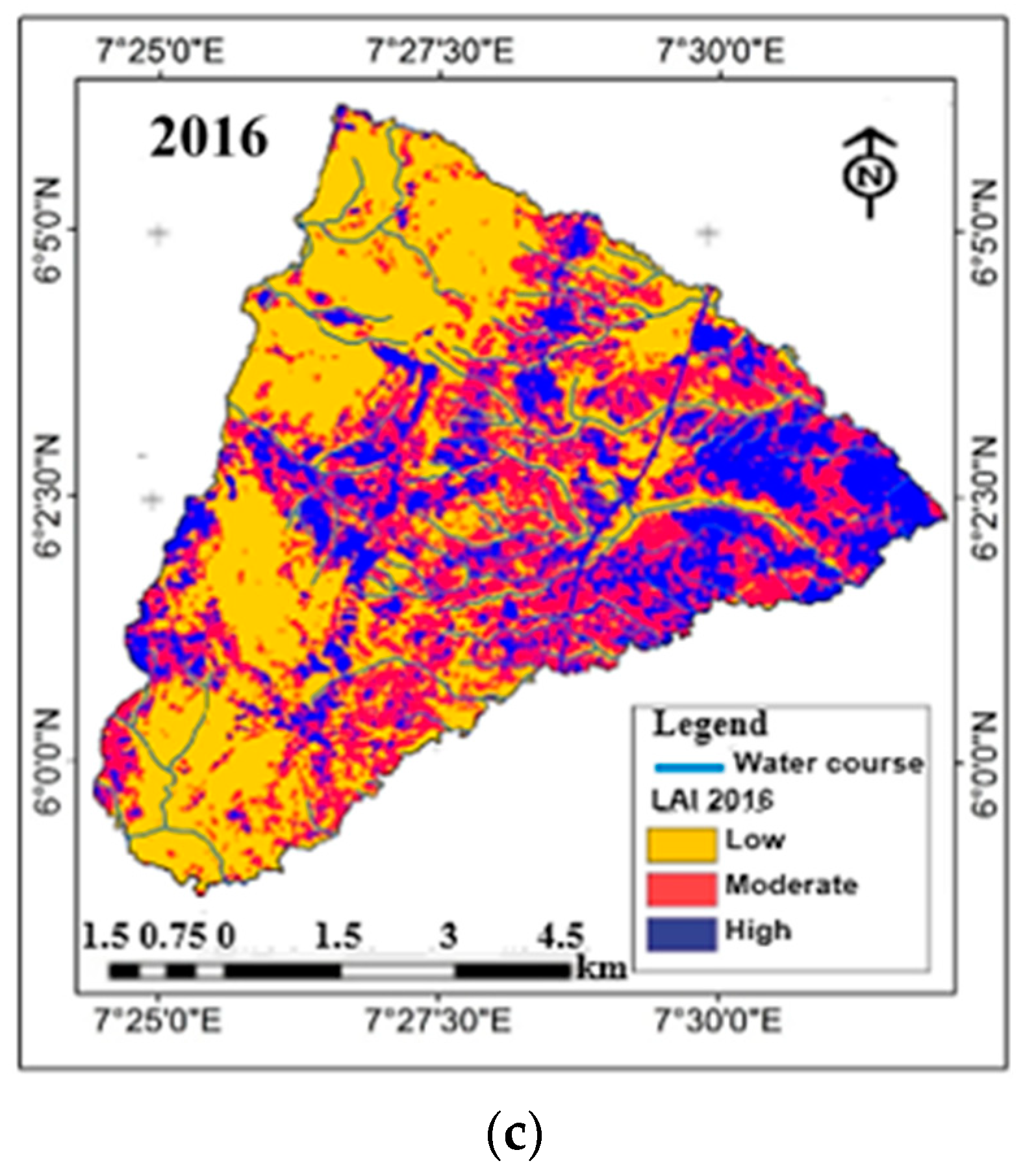
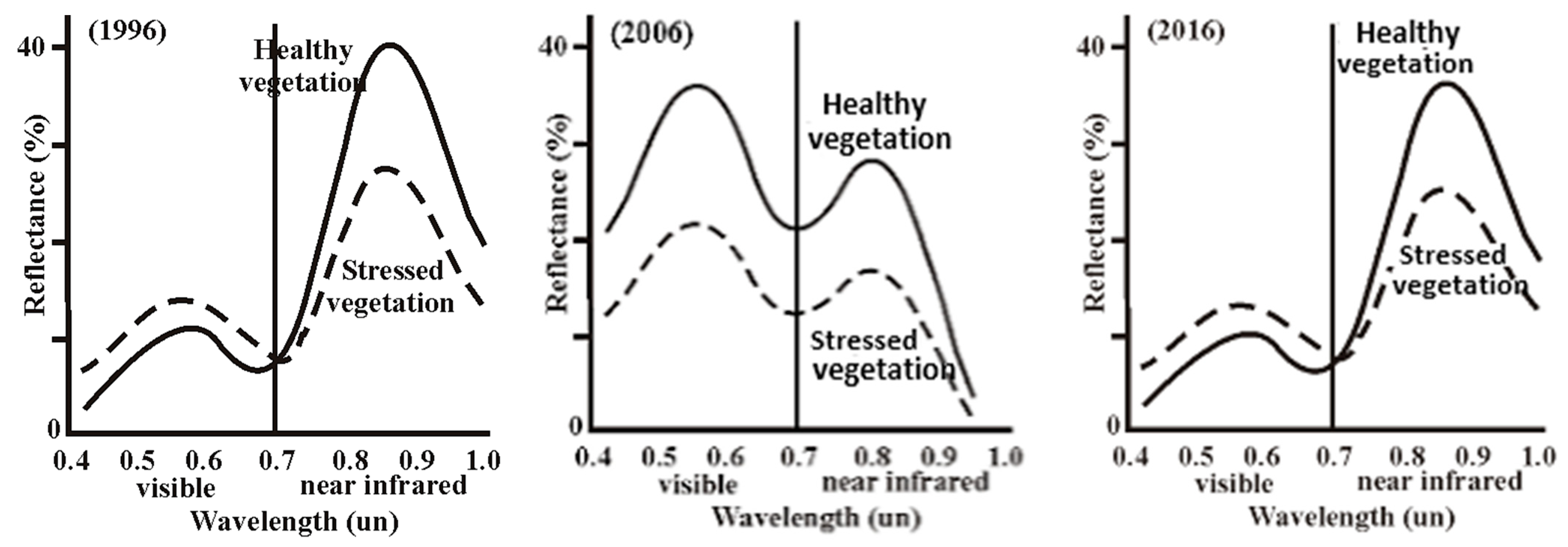
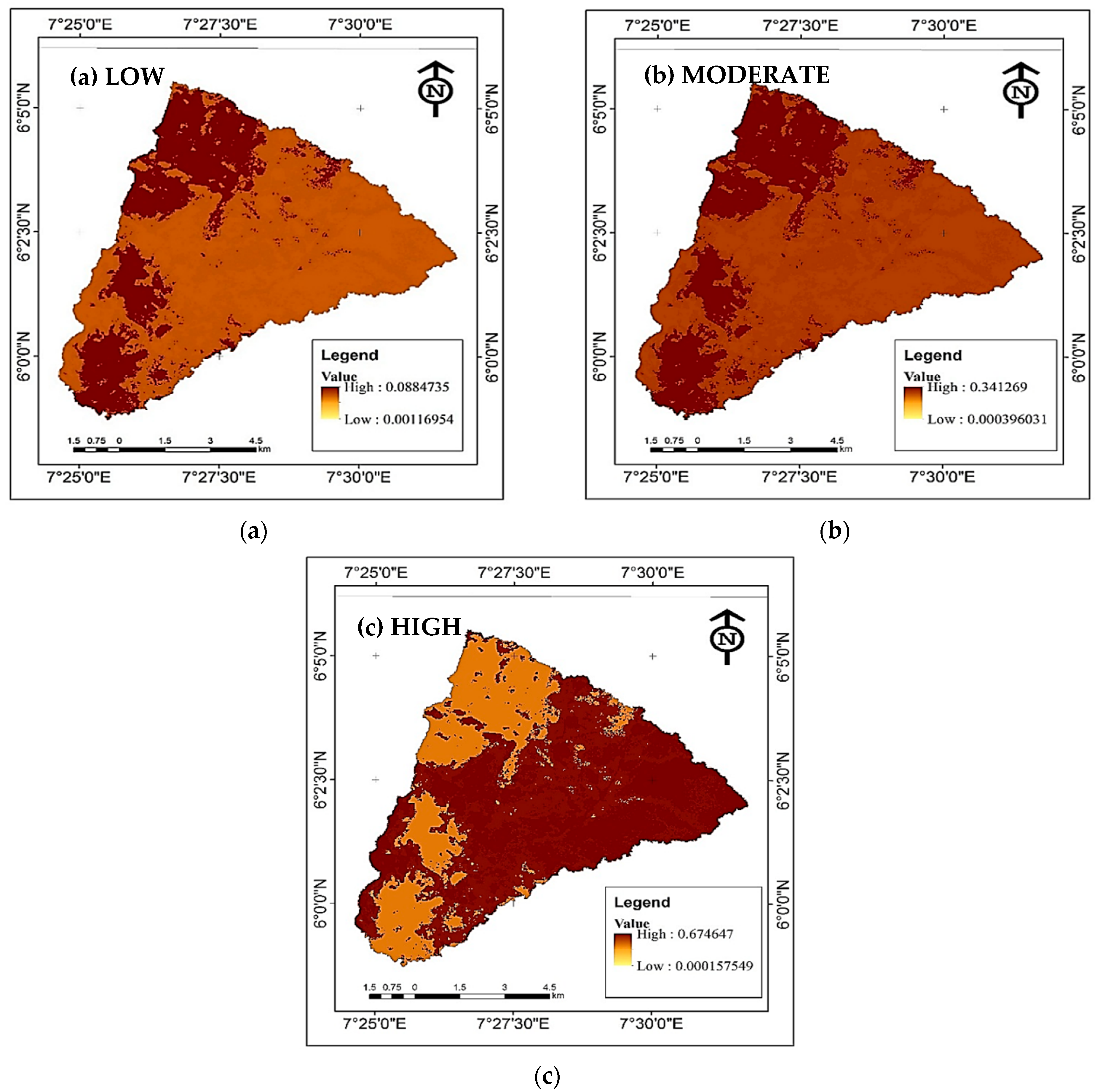

| Satellite Name | Path/Row | Sensor Type | Cloud Cover (%) | Year of Acquisition | UTM Zone | Spatial Resolution (Meters) |
|---|---|---|---|---|---|---|
| Landsat 5 | 188/055, 188/056 | TM | 0 | 1996 | 32 N | 30 × 30 |
| Landsat 7 | 188/055, 188/056 | ETM+ | 0 | 2006 | 32 N | 30 × 30 |
| Landsat 8 | 188/055, 188/056 | OLI | 0 | 2016 | 32 N | 30 × 30 |
| LAI Density Classes | 1996 LAI Classes | 2006 LAI Classes | 2016 LAI Classes | Trend (1996–2006) | Trend (2006–2016) | |||||
|---|---|---|---|---|---|---|---|---|---|---|
| Area (km2) | (%) | Area (km2) | (%) | Area (km2) | (%) | Area (km2) | Area (%) | Area (km2) | Area (%) | |
| Low | 41.2443 | 50.43 | 23.7006 | 28.98 | 38.2266 | 46.74 | −17.5437 | −21.45 | 14.5260 | 17.76 |
| Moderate | 33.9750 | 41.54 | 29.4777 | 36.04 | 27.5436 | 33.68 | −4.4973 | −5.5 | −1.9341 | −2.36 |
| High | 6.5610 | 8.02 | 28.6020 | 34.97 | 16.0101 | 19.58 | 22.0410 | 26.95 | −12. 5919 | −15.39 |
| (a) | Transition Probability Matrix | (b) | Cells That Are Expected to Transition | ||||
|---|---|---|---|---|---|---|---|
| LAI Categories | Probability of Changing to | Cells in | Expected to Transition to: | ||||
| Class 1 | Class 2 | Class 3 | Class 1 | Class 2 | Class 3 | ||
| Class 1 | 0.2329 | 0.3413 | 0.4258 | Class 1 | 6133 | 8987 | 11214 |
| Class 2 | 0.0643 | 0.2826 | 0.6531 | Class 2 | 2106 | 9256 | 21391 |
| Class 3 | 0.0502 | 0.2752 | 0.6746 | Class 3 | 1595 | 8745 | 21440 |
| LAI Categories | (a) 2030 (14 Years Planning Period) | (b) Trend (2016–2030) | ||
|---|---|---|---|---|
| Area (km2) | Area (%) | Area (km2) | Area (%) | |
| Low | 8.8668 | 10.842 | −29.3598 | −35.90 |
| Moderate | 24.2883 | 29.699 | −3.2553 | −3.98 |
| High | 48.6252 | 59.458 | 32.6151 | 39.88 |
| Total | 81.7803 | 100 | ||
Disclaimer/Publisher’s Note: The statements, opinions and data contained in all publications are solely those of the individual author(s) and contributor(s) and not of MDPI and/or the editor(s). MDPI and/or the editor(s) disclaim responsibility for any injury to people or property resulting from any ideas, methods, instructions or products referred to in the content. |
© 2022 by the authors. Licensee MDPI, Basel, Switzerland. This article is an open access article distributed under the terms and conditions of the Creative Commons Attribution (CC BY) license (https://creativecommons.org/licenses/by/4.0/).
Share and Cite
Enoh, M.A.; Onwuzuligbo, C.; Narinua, N.Y. Stimulating the Impact of Hydrocarbon Micro-Seepage on Vegetation in Ugwueme, from 1996 to 2030, Based on the Leaf Area Index and Markov Chain Model. Eng. Proc. 2023, 31, 47. https://doi.org/10.3390/ASEC2022-13830
Enoh MA, Onwuzuligbo C, Narinua NY. Stimulating the Impact of Hydrocarbon Micro-Seepage on Vegetation in Ugwueme, from 1996 to 2030, Based on the Leaf Area Index and Markov Chain Model. Engineering Proceedings. 2023; 31(1):47. https://doi.org/10.3390/ASEC2022-13830
Chicago/Turabian StyleEnoh, Mfoniso Asuquo, Chukwubueze Onwuzuligbo, and Needam Yiinu Narinua. 2023. "Stimulating the Impact of Hydrocarbon Micro-Seepage on Vegetation in Ugwueme, from 1996 to 2030, Based on the Leaf Area Index and Markov Chain Model" Engineering Proceedings 31, no. 1: 47. https://doi.org/10.3390/ASEC2022-13830
APA StyleEnoh, M. A., Onwuzuligbo, C., & Narinua, N. Y. (2023). Stimulating the Impact of Hydrocarbon Micro-Seepage on Vegetation in Ugwueme, from 1996 to 2030, Based on the Leaf Area Index and Markov Chain Model. Engineering Proceedings, 31(1), 47. https://doi.org/10.3390/ASEC2022-13830






